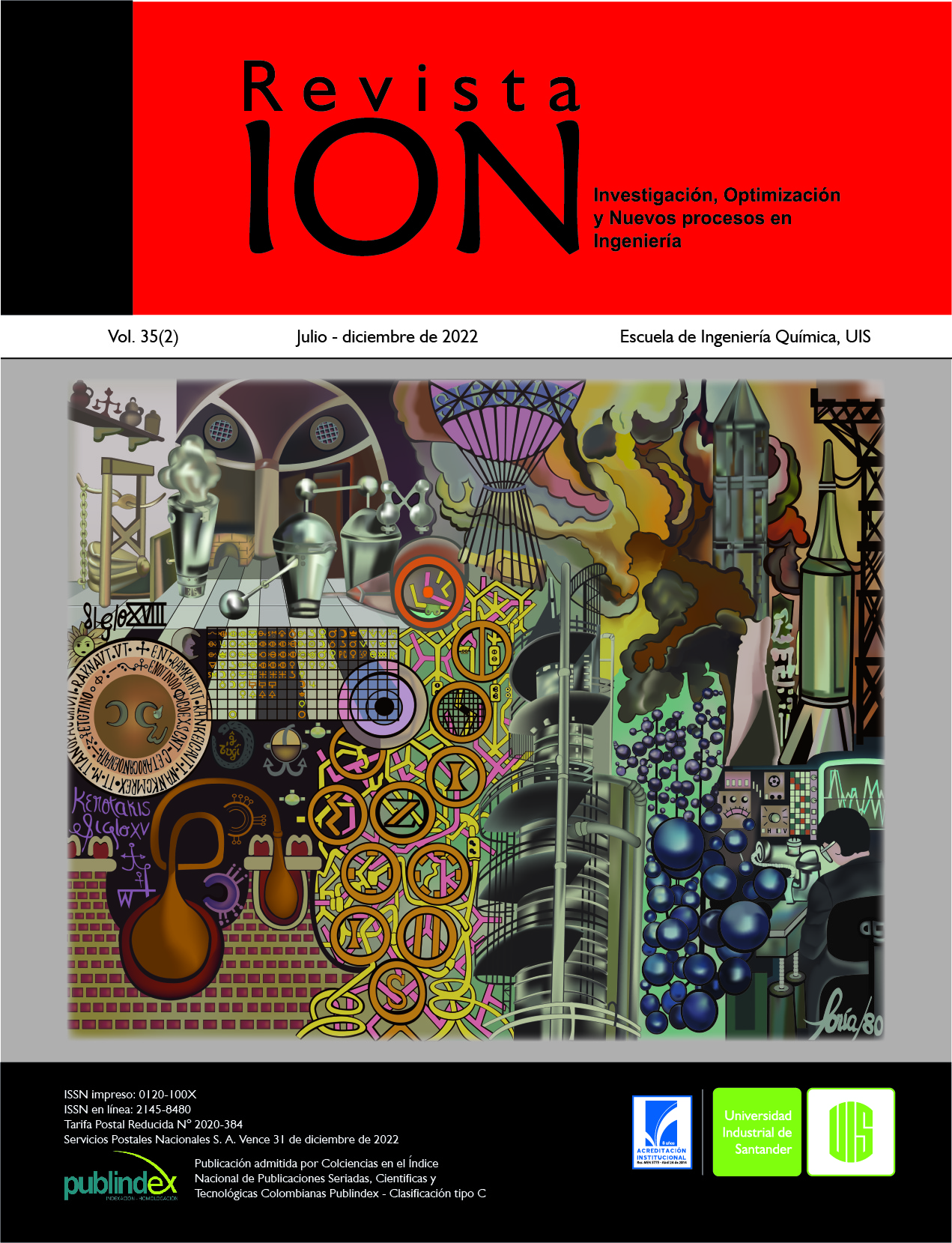A physicochemical look at the solubility of propane in N-formyl morpholine and sulfolane
Published 2022-12-02
Keywords
- Propane,
- Solubility,
- Organic Solvent,
- Krichevsky-Ilinskaya Parameters,
- Peng-Robinson PR
- Henry’s constant ...More
How to Cite
Copyright (c) 2022 Brandon Smith Martínez Costa

This work is licensed under a Creative Commons Attribution 4.0 International License.
Abstract
Worldwide propane gas or liquefied petroleum gas (LPG) has been widely used for various purposes, such as refrigerant gas, fuel, heating; among others. Propane is a hydrocarbon belonging to the paraffin family, which is considered soluble in some organic substances. The purpose of this reflection is to cover an interpretive and critical study on the solubility of propane in two organic solvents: N-formyl morpholine (NFM) and sulfolane at 298.15, 313.15 and 343.15 K, taking into account the pressure conditions in works already completed. This work includes a physicochemical perspective towards the analysis of pressure and temperature as the main quantitative factors in the binary systems propane (2) + NFM (1) and propane (2) + sulfolane (1); highlighting a critical and global analysis about the parameters of the Krichevsky-Ilinskaya equation (KI). Finally, and under the established conditions, the effects of the Peng-Robinson equation of state (PR EOS) are discussed, such as the binary interaction parameter (BIP), the alpha function and some modifications thereof.
Downloads
References
- Abbasov ZY, Fataliyev VM, Hamidov NN. The solubility of gas components and its importance in gas-condensate reservoir development. Pet. Sci. Technol. 2017;35(3):249-56. doi.org/10.1080/10916466.2016.1251459
- Granryd E. Hydricarbons as refrigetants-an overview. Int. J. Refrig. 2001;24(1),15-24. doi.org/10.1016/s0140-7007(00)00065-7
- Fleury D, Hayduk W. Solubility of propane in isomers of hexane and other non-polar solvents. Can. J. Chem. Eng. 1975;53(2):195-9. doi.org/10.1002/cjce.5450530207
- Mirgorod YA. Solubility of Ethane, Propane, and Butane in Aqueous Solutions of Sodium Dodecyl Sulfate. Russ. J. Gen. Chem. 2005;75(1):31-3. doi.org/10.1007/s11176-005-0167-4
- Jou F, Mather AE, Schmidt KA. Solubility of propane in N ‐formyl morpholine. Can. J. Chem. Eng. 2020;98(4):998-1002. doi.org/10.1002/cjce.23695
- Schmidt KA, Jou FY, Mather AE. Solubility of Propane in Sulpholane at Elevated Pressures. Can. J. Chem. Eng. 2008;84(2):256-9. doi.org/10.1002/cjce.5450840213
- Hayduk W, Wong CF. Solubility of propylene gas in octane and various polar solvents. Can. J. Chem. Eng. 1990;68(4):653-60. doi.org/10.1002/cjce.5450680417
- Mattson B. Microscale Gas Chemistry. Edu quím. 2005;16(4):514-528. doi.org/10.22201/fq.18708404e.2005.4.66089
- Miyano Y, Fukuchi K. Henry's constants of propane, propene, trans-2-butene and 1,3-butadiene in methanol at 255–320K. Fluid Phase. Equilib. 2004;226:183-7. doi.org/10.1016/j.fluid.2004.09.010
- Domańska U, Moollan WC, Letcher TM. Solubility of Sulfolane in Selected Organic Solvents. J. Chem. Eng. Data. 1996;41(2):261-5. doi.org/10.1021/je950236w
- Sciamanna SF, Lynn S. Solubility of hydrogen sulfide, sulfur dioxide, carbon dioxide, propane, and n-butane in poly (glycol ethers). Ind. Eng. Chem. Res. 1988;27(3):492-9. doi.org/10.1021/ie00075a020
- Henni A, Lal D, Mather AE. The solubility of ethane in n-methylpyrrolidinone. Can. J. Chem. Eng. 1996;74(3):423-5. doi.org/10.1002/cjce.5450740315
- Jou FY, Deshmukh RD, Otto FD, Mather AE. Solubility of H2S, CO2 and CH4 in N-formyl morpholine. Journal of the Chemical Society, Faraday Transactions 1: J. Chem. Soc. 1989;85(9):2675-82. doi.org/10.1039/f19898502675
- Peng DY, Robinson DB. A New Two Constant Equation of State. Ind. Eng. Chem. Fundam. 1976;15(1):59-64. doi.org/10.1021/i160057a011
- Prausnitz JM, Shair FH. A thermodynamic correlation of gas solubilities. AIChE. J . 1961;7(4):682-7. doi.org/10.1002/aic.690070430
- Jain D, Panda AK, Majumdar DK. Eudragit S100 entrapped insulin microspheres for oral delivery. AAPS PharmSciTech. 2005;6(1):E100—E107. doi.org/10.1208/pt060116
- Bradford ML, Thodos G. Solubility parameters of hydrocarbons. Can. J. Chem. Eng. 1966;44(6):345-8. doi.org/10.1002/cjce.5450440609
- Hildebrand JH. SOLUBILITY. J. Am. Chem. 1916;38(8):1452-73. doi.org/10.1021/ja02265a002
- Dariva C, Lovisi H, Mariac LC, Coutinho FM, Oliveira JV, Pinto JC. Propylene Solubility in Toluene and Isododecane. Can. J. Chem. Eng. 2008;81(1):147-52. doi.org/10.1002/cjce.5450810119
- Hayduk W, Asatani H, Miyano Y. Solubilities of propene, butane, isobutane and isobutene gases in n-Octane, Chlorobenzene and n-Butanol solvents. Can. J. Chem. Eng. 1988;66(3):466-73. doi.org/10.1002/cjce.5450660318
- Chappelow CC, Prausnitz JM. Solubilities of gases in high-boiling hydrocarbon solvents. AIChE. J. 1974;20(6):1097-104. doi.org/10.1002/aic.690200606
- Marufuzzaman M, Henni A. Solubility and diffusivity of propane in heavy oil and its SARA fractions. Can. J. Chem. Eng. 2014;92(8):1421-31. doi.org/10.1002/cjce.21977
- Myers AK, Myers AL. Prediction of mixed gas solubility at high pressure. Fluid. Phase. Equilib.1988;44(2):125-44. doi.org/10.1016/0378-3812(88)80108-0
- Orentlicher M, Prausnitz JM. Thermodynamics of hydrogen solubility in cryogenic solvents at high pressures. Chem. Eng. Sci. 1964;19(10):775-82. doi.org/10.1016/0009-2509(64)85088-0
- Patiño E, Aguilar G. Cinética de adsorción de propano y propileno en zeolita 5A-K. Adsorción irreversible inusual de propileno. Superf. Vacío. 2012;25(3),171-4. http://www.scielo.org.mx/scielo.php?pid=S1665-35212012000300005&script=sci_abstract
- Della Monica M, Jannelli L, Lamanna U. Physicochemical properties of sulfolane. J. Phys. Chem. 1968;72(3):1068-71. doi.org/10.1021/j100849a050
- Li X, Yang D. Determination of Mutual Solubility between CO2 and Water by Using the Peng– Robinson Equation of State with Modified Alpha Function and Binary Interaction Parameter. Ind. Eng. Chem. Res. 2013;52(38):13829-38.doi.org/10.1021/ie401365n
- Søreide I, Whitson CH. Peng-Robinson predictions for hydrocarbons, CO2, N2, and H2S with pure water and NaCI brine. Fluid Phase Equilib. 1992;77:217-40. doi.org/10.1016/0378-3812(92)85105-h
- Peng Dy, Robinson DB. Thermodynamics of Aqueous Systems with Industrial Applications WASHINGTON, D. C: AMERICAN CHEMICAL SOCIETY; Two- and Three-Phase Equilibrium Calculations for Coal Gasification and Related Processes; 1980. p. 393-414. doi.org/10.1021/bk-1980-0133.ch020
- Michel S, Hooper HH, Prausnitz JM. Mutual solubilities of water and hydrocarbons from an equation of state. Need for an unconventional mixing rule. Fluid Phase Equilib. 1989;45(2-3):173-89. doi.org/10.1016/0378-3812(89)80256-0
- Li H, Yang D. Modified α function for the Peng−Robinson equation of state to improve the vapor pressure prediction of non-hydrocarbon and hydrocarbon compounds. Energy Fuels. 2011;25(1):215-23. doi.org/10.1021/ef100927z
- Jou FY, Otto FD, Mather AE. The solubility of propane in 1,2-ethanediol at elevated pressures. J. Chem. Thermodyn. 1993;25(1):37-40. doi.org/10.1006/jcht.1993.1004
- Li X, Yang D, Zhang X, Zhang G, Gao J. Binary interaction parameters of CO2−heavyn- alkanes systems by using Peng–Robinson equation of state with modified alpha function. Fluid. Phase. Equilib. Junio de 2016;417:77-86. doi.org/10.1016/j.fluid.2016.02.016
- Jou FY, Schmidt KA, Mather AE. Solubility of Ethane in N-Formyl Morpholine. J. Chem. Eng. Data. 2003;48(2):224-5. doi.org/10.1021/je0255271
- Hildebrand JH, Lamoreaux RH. Solubility of Gases in Liquids: Fact and Theory. Ind. Eng. Chem. Fundam. 1974;13(2):110-5. doi.org/10.1021/i160050a004


